Muhammad Faraz Ul Abrar
Non-Convex Over-the-Air Heterogeneous Federated Learning: A Bias-Variance Trade-off
Oct 30, 2025Abstract:Over-the-air (OTA) federated learning (FL) has been well recognized as a scalable paradigm that exploits the waveform superposition of the wireless multiple-access channel to aggregate model updates in a single use. Existing OTA-FL designs largely enforce zero-bias model updates by either assuming \emph{homogeneous} wireless conditions (equal path loss across devices) or forcing zero-bias updates to guarantee convergence. Under \emph{heterogeneous} wireless scenarios, however, such designs are constrained by the weakest device and inflate the update variance. Moreover, prior analyses of biased OTA-FL largely address convex objectives, while most modern AI models are highly non-convex. Motivated by these gaps, we study OTA-FL with stochastic gradient descent (SGD) for general smooth non-convex objectives under wireless heterogeneity. We develop novel OTA-FL SGD updates that allow a structured, time-invariant model bias while facilitating reduced variance updates. We derive a finite-time stationarity bound (expected time average squared gradient norm) that explicitly reveals a bias-variance trade-off. To optimize this trade-off, we pose a non-convex joint OTA power-control design and develop an efficient successive convex approximation (SCA) algorithm that requires only statistical CSI at the base station. Experiments on a non-convex image classification task validate the approach: the SCA-based design accelerates convergence via an optimized bias and improves generalization over prior OTA-FL baselines.
Biased Federated Learning under Wireless Heterogeneity
Mar 08, 2025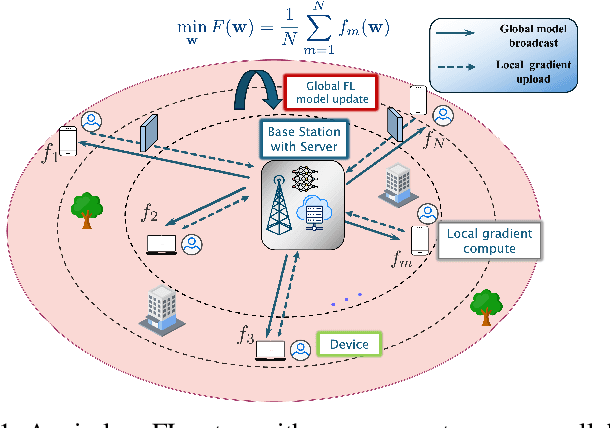


Abstract:Federated learning (FL) has emerged as a promising framework for distributed learning, enabling collaborative model training without sharing private data. Existing wireless FL works primarily adopt two communication strategies: (1) over-the-air (OTA) computation, which exploits wireless signal superposition for simultaneous gradient aggregation, and (2) digital communication, which allocates orthogonal resources for gradient uploads. Prior works on both schemes typically assume \emph{homogeneous} wireless conditions (equal path loss across devices) to enforce zero-bias updates or permit uncontrolled bias, resulting in suboptimal performance and high-variance model updates in \emph{heterogeneous} environments, where devices with poor channel conditions slow down convergence. This paper addresses FL over heterogeneous wireless networks by proposing novel OTA and digital FL updates that allow a structured, time-invariant model bias, thereby reducing variance in FL updates. We analyze their convergence under a unified framework and derive an upper bound on the model ``optimality error", which explicitly quantifies the effect of bias and variance in terms of design parameters. Next, to optimize this trade-off, we study a non-convex optimization problem and develop a successive convex approximation (SCA)-based framework to jointly optimize the design parameters. We perform extensive numerical evaluations with several related design variants and state-of-the-art OTA and digital FL schemes. Our results confirm that minimizing the bias-variance trade-off while allowing a structured bias provides better FL convergence performance than existing schemes.
Biased Over-the-Air Federated Learning under Wireless Heterogeneity
Mar 28, 2024Abstract:Recently, Over-the-Air (OTA) computation has emerged as a promising federated learning (FL) paradigm that leverages the waveform superposition properties of the wireless channel to realize fast model updates. Prior work focused on the OTA device ``pre-scaler" design under \emph{homogeneous} wireless conditions, in which devices experience the same average path loss, resulting in zero-bias solutions. Yet, zero-bias designs are limited by the device with the worst average path loss and hence may perform poorly in \emph{heterogeneous} wireless settings. In this scenario, there may be a benefit in designing \emph{biased} solutions, in exchange for a lower variance in the model updates. To optimize this trade-off, we study the design of OTA device pre-scalers by focusing on the OTA-FL convergence. We derive an upper bound on the model ``optimality error", which explicitly captures the effect of bias and variance in terms of the choice of the pre-scalers. Based on this bound, we identify two solutions of interest: minimum noise variance, and minimum noise variance zero-bias solutions. Numerical evaluations show that using OTA device pre-scalers that minimize the variance of FL updates, while allowing a small bias, can provide high gains over existing schemes.
Analog-digital Scheduling for Federated Learning: A Communication-Efficient Approach
Feb 02, 2024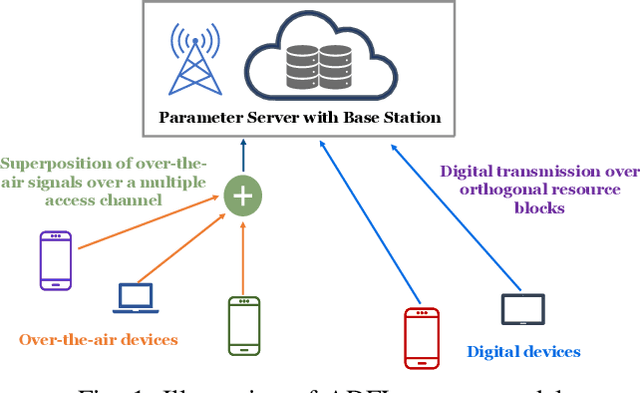
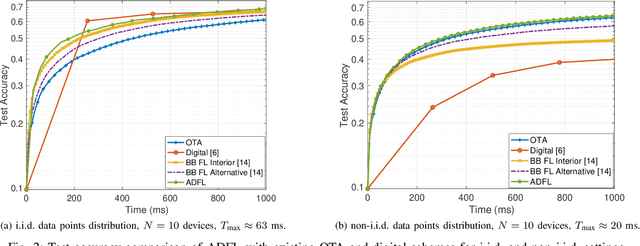
Abstract:Over-the-air (OTA) computation has recently emerged as a communication-efficient Federated Learning (FL) paradigm to train machine learning models over wireless networks. However, its performance is limited by the device with the worst SNR, resulting in fast yet noisy updates. On the other hand, allocating orthogonal resource blocks (RB) to individual devices via digital channels mitigates the noise problem, at the cost of increased communication latency. In this paper, we address this discrepancy and present ADFL, a novel Analog-Digital FL scheme: in each round, the parameter server (PS) schedules each device to either upload its gradient via the analog OTA scheme or transmit its quantized gradient over an orthogonal RB using the ``digital" scheme. Focusing on a single FL round, we cast the optimal scheduling problem as the minimization of the mean squared error (MSE) on the estimated global gradient at the PS, subject to a delay constraint, yielding the optimal device scheduling configuration and quantization bits for the digital devices. Our simulation results show that ADFL, by scheduling most of the devices in the OTA scheme while also occasionally employing the digital scheme for a few devices, consistently outperforms OTA-only and digital-only schemes, in both i.i.d. and non-i.i.d. settings.
STAR-RIS-Assisted Hybrid NOMA mmWave Communication: Optimization and Performance Analysis
May 13, 2022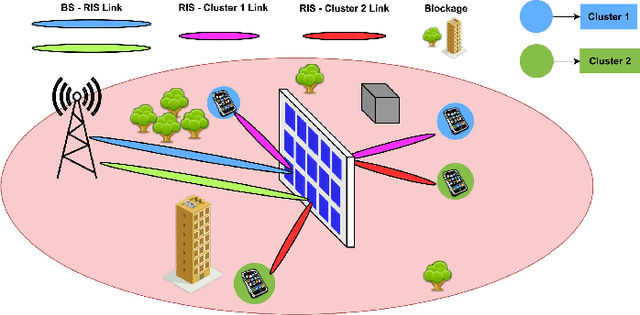
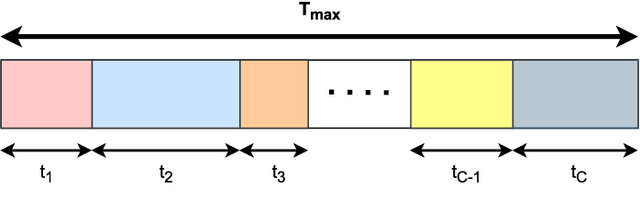
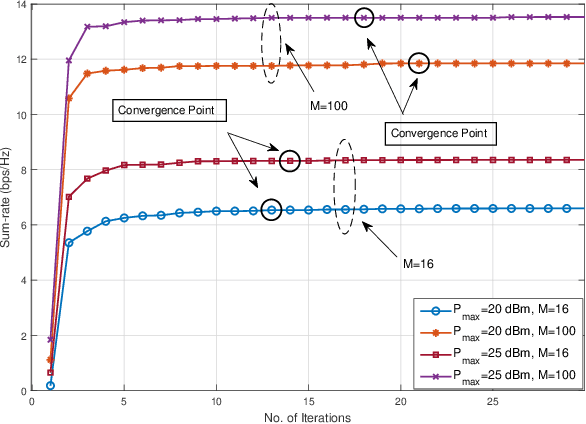
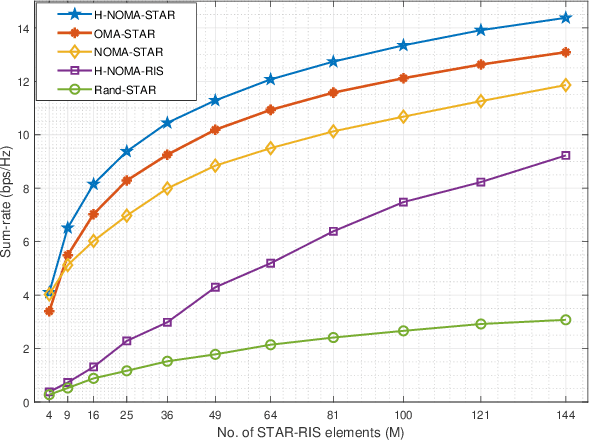
Abstract:Simultaneously reflecting and transmitting reconfigurable intelligent surfaces (STAR-RIS) has recently emerged as prominent technology that exploits the transmissive property of RIS to mitigate the half-space coverage limitation of conventional RIS operating on millimeter-wave (mmWave). In this paper, we study a downlink STAR-RIS-based multi-user multiple-input single-output (MU-MISO) mmWave hybrid non-orthogonal multiple access (H-NOMA) wireless network, where a sum-rate maximization problem has been formulated. The design of active and passive beamforming vectors, time and power allocation for H-NOMA is a highly coupled non-convex problem. To handle the problem, we propose an optimization framework based on alternating optimization (AO) that iteratively solves active and passive beamforming sub-problems. Channel correlations and channel strength-based techniques have been proposed for a specific case of two-user optimal clustering and decoding order assignment, respectively, for which analytical solutions to joint power and time allocation for H-NOMA have also been derived. Simulation results show that: 1) the proposed framework leveraging H-NOMA outperforms conventional OMA and NOMA to maximize the achievable sum-rate; 2) using the proposed framework, the supported number of clusters for the given design constraints can be increased considerably; 3) through STAR-RIS, the number of elements can be significantly reduced as compared to conventional RIS to ensure a similar quality-of-service (QoS).
 Add to Chrome
Add to Chrome Add to Firefox
Add to Firefox Add to Edge
Add to Edge